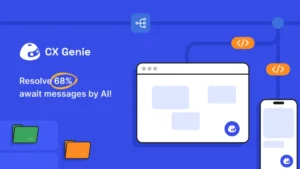Introduction
Artificial Intelligence (AI) has significantly evolved, impacting various industries and enhancing the efficiency of processes. One of the notable advancements in the AI domain is Remo AI, a cutting-edge platform designed to leverage the power of AI for a range of applications. This comprehensive guide explores the features, applications, benefits, and future potential of Remo AI, providing a detailed overview for anyone looking to understand and utilize this technology.
What is Remo AI?
Remo AI is an advanced AI platform that offers a suite of tools and solutions designed to help businesses and individuals harness the power of artificial intelligence. It focuses on automating tasks, providing deep insights through data analysis, and enhancing decision-making processes. Remo AI is known for its versatility, ease of use, and robust capabilities, making it suitable for a wide range of industries, including healthcare, finance, marketing, and more.
Key Features of Remo AI
1. Natural Language Processing (NLP)
Remo AI excels in natural language processing, enabling machines to understand, interpret, and respond to human language. This feature is crucial for applications like chatbots, sentiment analysis, and automated customer support.a
2. Computer Vision
Remo AI’s computer vision capabilities allow machines to interpret and make decisions based on visual data. This includes image and video recognition, object detection, and facial recognition, which are essential for applications in security, healthcare, and retail.
3. Predictive Analytics
Using advanced machine learning algorithms, Remo AI can analyze historical data to predict future trends and outcomes. This feature is particularly valuable in finance, marketing, and supply chain management, where forecasting and trend analysis are critical.
4. Automated Machine Learning (AutoML)
Remo AI’s AutoML feature simplifies the process of building and deploying machine learning models. It automates many of the complex tasks involved in model development, such as feature selection, model training, and hyperparameter tuning, making it accessible to users with varying levels of expertise.
5. Data Integration
The platform supports integration with various data sources, including databases, APIs, and cloud storage, allowing users to centralize their data and streamline their workflows. This integration capability ensures that all relevant data is easily accessible and can be analyzed comprehensively.
6. Scalability
Remo AI is built on a scalable infrastructure, allowing it to handle large volumes of data and complex computations. This scalability ensures that the platform can support projects of any size, from small businesses to large enterprises.
7. Security
Security is a top priority for Remo AI. The platform employs robust security measures, including data encryption, access controls, and regular security audits, to protect user data and ensure compliance with industry standards.
Applications of Remo AI
1. Healthcare
In the healthcare industry, Remo AI can be used for predictive analytics to forecast patient outcomes, identify potential health risks, and optimize treatment plans. Its computer vision capabilities can assist in medical imaging analysis, helping doctors detect diseases early and accurately.
2. Finance
Remo AI’s predictive analytics and machine learning models are valuable in the finance sector for fraud detection, risk management, and automated trading. The platform can analyze transaction data in real-time, identify unusual patterns, and flag potential fraudulent activities.
3. Marketing
Marketers can leverage Remo AI to analyze customer data, segment audiences, and personalize marketing campaigns. Its NLP capabilities can be used for sentiment analysis, helping businesses understand customer opinions and improve their products and services.
4. Retail
In retail, Remo AI can enhance inventory management, optimize pricing strategies, and improve customer experiences. Its computer vision technology can be used for in-store analytics, such as tracking customer movements and detecting shelf stock levels.
5. Manufacturing
Manufacturers can use Remo AI for predictive maintenance, quality control, and supply chain optimization. The platform can analyze data from sensors and machines to predict equipment failures before they occur, reducing downtime and improving operational efficiency.
Benefits of Using Remo AI
1. Enhanced Decision Making
Remo AI provides deep insights through data analysis, enabling businesses to make informed decisions. By leveraging predictive analytics and machine learning, companies can identify trends, anticipate challenges, and seize opportunities.
2. Increased Efficiency
The platform automates repetitive and time-consuming tasks, freeing up valuable resources and allowing employees to focus on more strategic activities. This automation leads to increased productivity and efficiency.
3. Improved Customer Experience
Remo AI’s NLP and sentiment analysis capabilities help businesses understand and respond to customer needs more effectively. By personalizing interactions and addressing concerns promptly, companies can enhance customer satisfaction and loyalty.
4. Cost Savings
By optimizing processes and reducing manual intervention, Remo AI can help businesses lower operational costs. Predictive maintenance, for example, minimizes equipment downtime and reduces repair costs.
5. Scalability and Flexibility
Remo AI’s scalable infrastructure ensures that it can grow with your business. Whether you’re a small startup or a large enterprise, the platform can handle your data and computational needs, providing flexibility to adapt to changing requirements.
Getting Started with Remo AI
1. Sign Up and Set Up
To get started with Remo AI, visit their website and sign up for an account. Once registered, you can set up your profile and explore the platform’s features.
2. Integrate Data Sources
Connect your data sources to Remo AI, whether they are databases, APIs, or cloud storage. This integration allows you to centralize your data and streamline your workflows.
3. Build and Train Models
Use the AutoML feature to build and train machine learning models. Remo AI simplifies this process by automating many of the complex tasks involved in model development.
4. Deploy Models
Once your models are trained, you can deploy them within the platform. Remo AI provides tools for monitoring model performance and making adjustments as needed.
5. Analyze and Visualize Data
Leverage Remo AI’s analytics and visualization tools to gain insights from your data. Use these insights to make informed decisions and optimize your operations.
6. Collaborate with Team Members
Invite team members to collaborate on your projects. Use the platform’s collaborative features to share data, insights, and models, ensuring that everyone is aligned and can contribute effectively.
Tips for Maximizing the Use of Remo AI
- Start with Clear Objectives: Before using Remo AI, define your objectives and what you hope to achieve. This will help you focus your efforts and make the most of the platform’s capabilities.
- Leverage Pre-trained Models: Take advantage of Remo AI’s pre-trained models to get started quickly. These models can be customized and fine-tuned to meet your specific needs.
- Continuously Monitor and Update Models: Regularly monitor the performance of your models and update them as needed. This ensures that they remain accurate and relevant as your data and requirements change.
- Utilize Data Integration: Integrate all relevant data sources to ensure comprehensive analysis. Centralized data allows for more accurate insights and better decision-making.
- Engage in Continuous Learning: Stay updated with the latest advancements in AI and machine learning. Continuous learning will help you leverage new features and capabilities as they become available.
The Future of Remo AI
As AI technology continues to evolve, the potential applications and capabilities of Remo AI are expected to expand. Future developments may include:
1. Enhanced Automation
Further advancements in AI and machine learning will enable even greater levels of automation, reducing the need for human intervention in complex tasks.
2. Integration with IoT
Integrating Remo AI with the Internet of Things (IoT) will enable more sophisticated data collection and analysis, leading to smarter and more responsive systems.
3. Advancements in AI Ethics
As AI becomes more integrated into various aspects of life, addressing ethical considerations will be crucial. Remo AI is likely to incorporate more features to ensure fairness, transparency, and accountability in AI decision-making processes.
4. Expansion into New Industries
Remo AI is expected to expand into new industries, such as agriculture, energy, and entertainment, where AI-driven insights and automation can provide significant benefits.
5. Improved User Experience
Ongoing improvements in the platform’s user interface and accessibility will make it even easier for users to leverage AI, regardless of their technical background.
Conclusion
Remo AI represents a significant advancement in the field of artificial intelligence, offering powerful tools and solutions that can transform industries and improve outcomes. From healthcare to finance, marketing to manufacturing, Remo AI’s versatile and user-friendly platform enables businesses to harness the full potential of AI. By understanding the features, applications, and benefits of Remo AI, you can make informed decisions and leverage this technology to enhance your operations and achieve your objectives.
As AI technology continues to evolve, the possibilities for Remo AI are limitless, promising a future where AI-driven innovations enhance every aspect of our lives. Embrace the power of Remo AI today and unlock new possibilities for automating tasks, gaining insights, and making smarter decisions.








